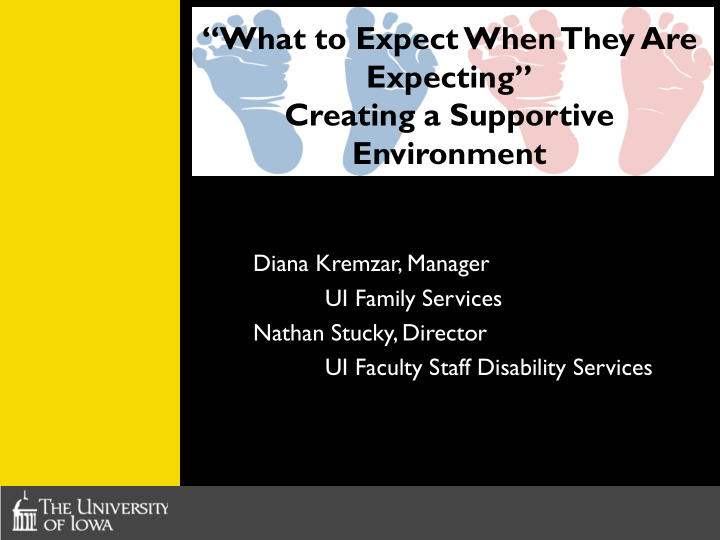



“What to Expect When They Are Expecting” Creating a Supportive Environment Diana Kremzar, Manager UI Family Services Nathan Stucky, Director UI Faculty Staff Disability Services
Our goal To provide an environment and culture where employees becoming new parents are treated fairly during pregnancy, upon their return to work, and beyond to allow them the ability to be successful in their professional lives and to provide a supportive work/life balance.
Presentation Agenda • Goals • Themes across campus • Policies • Best Practices • Resources
Employer Benefits • Retention • Morale • Presenteeism • Productivity • Quality of service • Sick leave usage • Health care costs
Themes on Campus • Confusion among expectant parents, supervisors & HR reps about policies • High anxiety about pregnancy and possible effects on work • Subtle or more obvious tension from supervisors & coworkers • Perceived lack of support if accommodations are needed. • Perceived lack of support & flexibility upon return
Pregnancy Discrimination under Chapter 216 of the Iowa Code 216.6 (2)(e) • “…the employer of the pregnant employee shall not refuse to grant to the employee who is disabled by the pregnancy a leave of absence if the leave of absence is for the period that the employee is disabled because of the employee’s pregnancy, childbirth, or related medical conditions, or for eight weeks, whichever is less.”
The Family and Medical Leave Act of 1993 (FMLA) ecfr 825.100 (a) “…allows eligible employees of a covered employer to take job-protected, unpaid leave, or to substitute appropriate paid leave…for up to a total of 12 workweeks in any 12 months because of the birth of a child and to care for the newborn child, because of the placement of a child with the employee for adoption or foster care…”
The Family and Medical Leave Act of 1993 (FMLA) ecfr 825.101 (a) Purpose of the Act. “FMLA is intended to allow employees to balance their work and family life by taking reasonable unpaid leave…for the birth or adoption of a child, for the care of a child…The Act is intended to balance the demands of the workplace with the needs of families, to promote the stability and economic security of families, and to promote national interests in preserving family integrity.”
Application of FMLA • Appointments • Light duty/bed rest • Medical Recovery • Bonding time with newborn • Intermittent bonding time • Shared leave time with parents
Paid Leave Accruals • Sick Leave • Vacation • Family Caregiving Leave • Catastrophic Leave • Unpaid Leave • Consider any provisions or language under Collective Bargaining Agreements
How can we create a supportive environment?
3 Meeting Model 1. Celebration & Reassurance 2. Transition Plan 3. Post-Leave Conversation
Meeting 1: Celebration & Reassurance • CONGRATULATE!!! • Assurance of support • Direct to parental leave resources & HR rep
Meeting 2: Transition Plan • Approx. 3 months before scheduled leave • Collaborative effort • Items to consider: – Key dates – Reprioritization – Ability to postpone activities?
Meeting 3: Post-Leave Conversation • Final revisions to transition plan • Keeping in touch preferences
Returning to Work • Be welcoming • Allow time to catch up • Check-in regularly • Be sensitive
Returning to Work: FMLA or non-FMLA • Returning to work prior to end of 6 week medical recovery. • Work release needed • Returning to work prior to exhaustion of 12 weeks. • Intermittent bonding time • What happens when an employee runs out of FMLA and is still out on leave?
Returning to Work: Flexible Work Arrangements (FWA) • No one-size-fits-all approach • Benefits (low cost/high impact) • Examples: • Non-traditional start and stop times • Compressed work weeks • Telecommuting
Returning to Work: Lactation Needs The University of Iowa follows and supports the guidelines established under the Fair Labor Standards Act (FLSA) that requires employers to: “ reasonable break time for an employee to express breast milk for her nursing child for 1 year after the child’s birth each time such employee has need to express the milk.” ”Employers are not required under the FLSA to compensate nursing mothers for breaks taken for the purpose of expressing milk. However, where employers already provide compensated breaks, an employee who uses that break time to express milk must be compensated in the same way that other employees are compensated for break time.”
Returning to Work: Lactation Needs • Communication is encouraged • Plan should meet the lactation needs of the employee and not disrupt service as much as possible. • Flexibility is encouraged
UI Family Services • Lactation support & resources • FWA consultations • Child care connections – Campus connected centers – Back-up care hr.uiowa.edu/well-being/family-services
Parental Leave Webpage • Leave policies • Best Practice Guides – For employees – For supervisors/HR reps • Return to Work Resources – Policies – Flexible work arrangements – Lactation resources hr.uiowa.edu/support/faculty-and-staff- disability-services/parental-leave
Additional UI Resources • Faculty & Staff Disability Services • UI Health Care Leave & Disability Administration Office • Employee Assistance Program • Office of the Ombudsperson • liveWELL/Health Coaching
Questions?
“What to Expect When They Are “What to Expect When They’re Expecting” Expecting” Creating a Supportive Environment Thank you! Diana Kremzar, Manager UI Family Services Nathan Stucky, Director UI Faculty Staff Disability Services
Recommend
More recommend